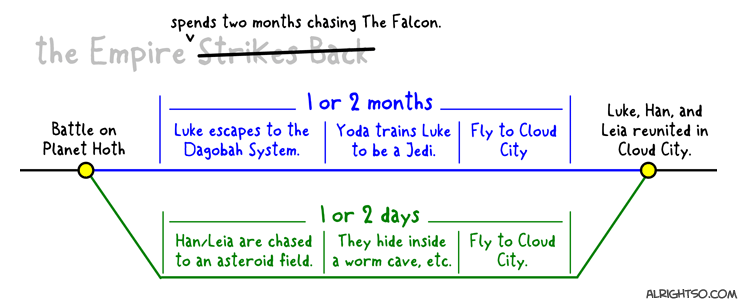Do plot holes matter?
Plot holes are one of the most-discussed film topics on the internet. People never grow tired of dissecting film narratives in search of logical errors that harm the authenticity of the story. Half of the time what people call plot holes aren’t actually plot holes but mere inconsistencies, or nonexistent nitpicked problems fabricated by personal reactions to a film. Other plot holes are endlessly discussed as explanations are conceived. But do they really matter? Yes and no—many notable filmmakers feel it all depends on the severity of the plot hole, how it impacts the viewing experience, and who you’re asking.
If a plot hole is so glaring that it takes the viewer out of the story, breaking the suspension of disbelief and causing harm to the enjoyment of the narrative, most people would say it matters. If a minor discrepancy in the plot doesn’t break enjoyment of the film, to the average audience member it’s no big deal. In reality, small plot holes exist in nearly every story. It’s the size of the metaphorical hole that determines its significance.
In Patrick McGilligan’s book “Backstory 1: Interviews with Screenwriters of Hollywood’s Golden Age,” screenwriter Richard Maibaum discusses working with Alfred Hitchcock on Foreign Correspondent (1940). He says, “I was writer number thirty… primarily I rewrote the… part of the old statesman who was kidnapped. (Hitchcock) said to me, ‘Did you read what we’ve got?’ Which was half a screenplay. I said, ‘Yes.’ He said, ‘What do you think about it?’ I replied, ‘It’s not very logical.’ He grimaced and said, ‘Oh, dear boy, don’t be dull. I’m not interested in logic, I’m interested in effect. If the audience ever thinks about logic, it’s on their way home after the show, and by that time, you see, they’ve paid for their tickets.’”
This speaks directly to the point—emotions matter more than logic. If the film is emotionally sound, it won’t break the viewer’s engagement with the picture even if there are fallacies in the story. Plot holes only matter if they sever that emotional bond.
Howard Hawks had similar sentiment when discussing his confusing masterpiece The Big Sleep (1946). As noted by Richard Rouse in his book “Game Design,” Hawks said, “Making this picture, I realized that you don’t really have to have an explanation for things. As long as you make good scenes you have a good picture—it doesn’t matter.”
Jonathan Demme refers to ignorable plot holes as “refrigerator questions”—plot points that viewers don’t start contemplating until they’ve gone home from the film and are standing in front of the refrigerator, suddenly thinking, “how could that have happened?” If it takes a viewer that long to realize, it didn’t matter. It didn’t take them out of the film.
Of course, Hawks and Hitchcock are two of the most regarded directors who ever worked in films, and Demme is responsible for modern classics like The Silence of the Lambs (1991) and Philadelphia (1993).
Films almost never show every detail of the story being told. They span time—sometimes decades—in the course of hours, leaving the viewer to fill in the details and gaps between moments. Good writing, good editing, and good direction will make these gaps feel seamless. Lesser construction calls attention to the issues in a story, taking the viewer out of the experience. If the viewer’s engagement drops because of mistakes in the story or its composition, that’s when problems exist.
The genre and style of the movie is also a factor in determining how much plot logic is required. Action movies, for example, may be one of the more illogical genres. It’s debatable that any James Bond or Fast and Furious movie exists without some plot holes, if one were to really think about them. But the films are fast, fun and entertaining, so most audiences don’t care or notice their flaws. In the science fiction genre, on the other hand, while there will inevitably be liberties due to the fictional aspect, audiences expect a certain degree of coherence and consistency in explaining the alternate reality they’re temporarily inhabiting.
To take one case study, an image recently circulating the Internet points out the chronological insanity of The Empire Strikes Back (1980). The film is split between two ongoing stories, one with Yoda (Frank Oz) training Luke (Mark Hammill) and one with Han (Harrison Ford) and Leia (Carrie Fisher) traveling to Cloud City. Somehow everyone meets up at Cloud City, but the interim timelines are vastly different.

The Empire Strikes Back timeline
Does this make The Empire Strikes Back a bad movie? No, because it doesn’t break the viewer’s engagement. In fact, it is often cited as the best of the entire Star Wars franchise.
As it is, movies are all about the lasting effect. If you walk away from a film satisfied and entertained, any plot holes within were irrelevant. If you sat through the picture scrutinizing it as it unfolded, the problems were rampant. The aggregated substance of all components of a film’s construction help determine the impact of its plot holes, for better or worse.

